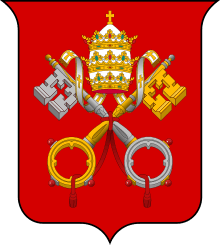Bramante Staircase
Bramante Staircase is the name given to two staircases in the Vatican Museums in the Vatican City State; the original stair, built in 1505 and a modern equivalent, from 1932.
The original staircase
.jpg)
The original Bramante staircase, in the Pio-Clementine Museum, was built in 1505 to a design by Donato Bramante. It connects the Belvedere palace of Pope Innocent VIII to the outside and stands in a square tower of that building.[1] The Bramante Staircase features granite Doric columns and a herringbone paving pattern, and was designed to allow people and pack animals to ascend and descend without interruption.[1] The stair is cited as the inspiration for Antonio da Sangallo the Younger's design for the double helix passageway at the well of St Patrick in Orvieto, to solve a similar logistical problem. The staircase was built to allow Pope Julius II to enter his private residence while still in his carriage, since walking up the several flights in heavy papal vestments would have been onerous.
It is not generally open to the public, though specialist tours do visit.[1]
The modern staircase

The modern double helix staircase, also in the Pio-Clementine Museum, and commonly referred to as the "Bramante Staircase", was designed by Giuseppe Momo in 1932 and was inspired by the original Bramante Staircase. This staircase, like the original, is a double helix, having two staircases allowing people to ascend without meeting people descending; as with the original the main purpose being to allow uninterrupted traffic in each direction. It encircles the outer wall of a stairwell of approximately fifteen meters wide and with a clear space at the centre. The balustrade around the ramp is of ornately worked metal. A canopy located above provides the necessary light to illuminate the stairs. The staircase is located at the end of the museum visit and all visitors leave by this route.[2]
See also
References
- 1 2 3 Bramante Staircase at insightvacations.com Retrieved 23 August 2015
- ↑ Bramante staircase at photovoyage.org (French)
External links
- Secrets of the Vatican;Bramante's double staircase at viator.com
- Bramante staircase at myvatcantours.com
Coordinates: 41°54′23″N 12°27′16″E / 41.9064°N 12.4544°E
